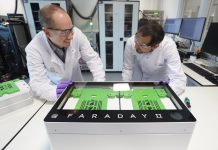
Avalon president Matt Harper believes vanadium-based energy storage can be cheaper than lithium. On a whole life basis, he claims it already is.
US-based Avalon is merging with UK-based vanadium storage firm RedT via reverse takeover.
RedT is involved in projects including the Oxford Superhub, where it aims to deliver a 2MW/5MWh flow storage battery to complete a 52MW lithium-flow hybrid. The battery will be used to help enable a smart grid, which wraps in electric vehicle charging, heat pumps and energy balancing and trading.
Harper, who is also Avalon co-founder and chief product officer, says flow storage’s ability to perform multiple roles without degradation is what will ultimately set it apart.
He claims the new merged company – Invinity – will also prove that relatively high costs associated with flow storage can be reduced through standardisation, both of manufacturing and of business models.
Cost curves
For now, Avalon’s customer base is primarily individuals with solar in California. But Harper says the firm also has around a dozen industrial and commercial (I&C) installations up and running – and that delivering those units has enabled greater efficiencies in manufacturing.
“We have a rigorous focus on standardisation,” he says. “Most of the other flow batteries have delivered hand-built projects, which is not a good way to get to good cost or quality control.”
Harper says there are multiple factors behind the drive to standardisation.
“In the solar market, megawatt scale plant are being built in weeks, but the flow batteries are taking months or years. So we had to come with something totally standardised and that left the factory complete.
“That has enabled us to drive absolutely all the excess cost out of these things, to a point where we are broadly comparable on capital cost with lithium systems,” claims Harper, without lithium ion’s additional maintenance costs.
Over a 20-30 year lifetime, Harper claims flow batteries can be “up to 60 per cent cheaper” than their lithium equivalents.
Meanwhile he says greater throughput enabled by non-degradation of vanadium electrolyte “gets you to a better position” in terms of RoI, because flow batteries can cycle more, to greater depth of discharge, and essentially work harder for longer.
Bumpy ride
The theory stacks up. The problem for vanadium redox flow battery players and investors is pretty much everyone else is backing lithium – and lithium battery costs continue to fall.
RedT’s share price, on a broadly downward trend for some years, collapsed a year ago after the company started to reveal the extent of its cashflow problems (although it has increased 55 per cent off a low base since AIM market readmission earlier this month).
Vanadium mining company Bushveld, with whom RedT and Avalon have struck an ‘electrolyte-as-a-service’ supply deal, saw its share price broadly halve in the year to February. It has since halved again – though due to the market-wide Coronavirus rout than anything else.
However, Avalon is convinced in the fundamentals of the business – and RedT has managed to raise a further $7.9m (updated, £8m) from shareholders to fund Invinity’s growth.
Funds and funding
Within the I&C sector, delivering that growth requires standardisation of business model as well as product, says Harper, “which is where we are looking to put the additional funding post-merger”.
RedT struck a deal with Norwegian state-owned utility Statkraft last year to try and package a funded solution to the industrial and commercial market. To date, it has delivered nothing, but Harper believes results will come in the next 12 months.
“I am [confident],” says Harper. “Compare it to where the solar industry was five or six years ago. Solar’s success was not [just] about decreases in cost. It was standardisation around structures that allowed the industry to flourish. I think we will see the same here for commercial and industrial, either standalone or co-located.”
The Statkraft deal and electrolyte financing with Bushveld, he adds, “to me look very repeatable”.
Burning issue
Harper also believes the transition to electric vehicles and incoming grid capacity constraints will drive growth for flow storage, both within industrial and commercial and utility markets – in tandem with safety concerns in urban areas.
He thinks the Los Angeles Department of Water and Power (LADWP), the largest municipal utility in the United States, may soon be a big customer for that reason.
“LADWP have said they will install 1.2GWh of batteries in the next four years … because they see capacity crunches coming. That is a massive opportunity and will make a huge difference to the addressable market we can serve,” says Harper.
“LADWP is interested in us for two reasons – because they will require long duration [storage] to provide power overnight; and at sites where batteries are adjacent to residential networks and they perceive a fire risk.”
According to Harper, it is “challenging to mitigate that risk at specific distribution nodes” with lithium ion technologies. “It is a different ball game that requires different technologies.”
One way or another, the next few years will likely determine which technologies end up delivering that requirement.
Related stories:
To Invinity and beyond: RedT and Avalon merger set to complete
RedT strikes Bushveld deal, gets green light for 5MWh storage unit
EDF and Wärtsilä strike 100MW battery deal
Oxford goes large on storage, EVs and heat pumps
Habitat Energy: 2019 will be “breakthrough year” for battery storage
Pivot Power makes huge play for 2GW battery storage and EV charging network
Flow storage firms RedT and Avalon set to merge
Energy storage ‘will wipe out battery storage’
Click here to see if you qualify for a free subscription to the print edition or to renew.
Follow us at @EnergystMedia. For regular bulletins, sign up for the free newsletter.




….”can be much cheaper”. Great but it isn’t now, even at low vanadium prices. At a 30 year levelized cost it may be cheaper than Li-On. But which customer is going to take that technology risk over 30 years? And I am not talking about economically unviable pilot projects such as the one mentioned above.
Probably the same customers who take 20-30 year risk on wind and PV components. An example is EDF, the French power utility and global IPP investor, which owns the Oxford Superhub project mentioned in the article. In that use case, the VRFB must already be cheaper than lihtium ion, given that lithium ion is used in that same project for other functionalities.
Probably the same customers who can do basic maths and don’t want their posterior singer energy route
Posterior singed en route
And probably the responsible customer who doesn’t want to risk poisoning a whole community with hydrogen fluoride gas when a fire does break out and the fire department can do nothing to help.